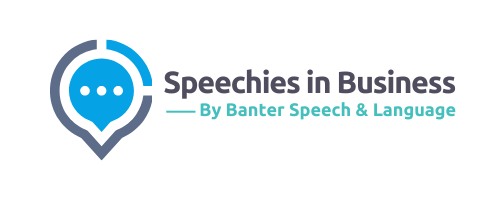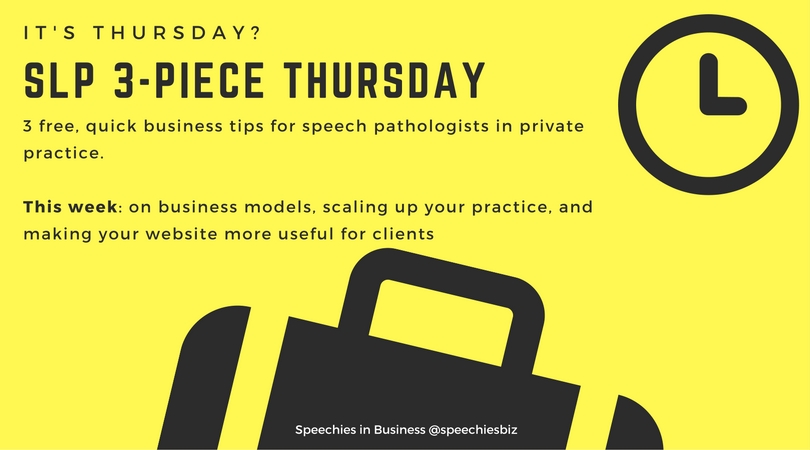SLP Three-piece Thursday 5: on business models, scaling up your practice, and making your website more useful for clients
- On getting your business model right:
- Are you looking to service the “mass market” for speech pathology services (e.g. children with communication issues), or just a niche (e.g. adult voice, or stuttering, or working only with children with ASD)?
- What value do you give clients?
- What “channels” do you use to sell your services, e.g. direct vs parent training, in a clinic, in schools, home visits, one-to-one, groups, telehealth?
- Do you sell products too?
- Will you personalise communications, automate communications, or use a combination of the two?
- Are some parts of your business self-service (e.g. online bookings)?
- Do you earn a fee per service, or do people book and pay for blocks of therapy like a subscription?
- What resources do you need? (a) physical resources (e.g. office, equipment); (b) human resources: staff, contractors, advisors, (e.g. lawyers and accountants); and (c) intellectual resources: your copyrights, licences, etc for assessments and therapy resources – your tools of the trade.
- What are your critical activities? production (e.g. session preparation/set up), problem-solving (e.g. developing management plans and recommendations), partnerships (e.g. alliances with key referrers and other speech pathologists).
- What’s your cost structure? Are you low cost, high volume (requiring lots of automation), or low volume, high cost (requiring lots of tailoring and extra servicing of clients)?
- What do your customers really need? Empathise with them: what do they think and feel when they come to you, what do they see when they see you, what do they hear, what do they say to others about you?
- Who is your ideal client? Think age, interests, needs.
- What emotions do clients feel when they use your practice? Write business scenarios about telling your ideal clients’ stories.
- Offer free services, e.g. community talks, eBooks and blogs, so potential clients can get to know you.
To succeed in business you need to add value to your client’s lives. For more information, see: Business Model Generation by Alexander Osterwalder and Yves Pigneur. Also, our related resources: Profit Calculator (break-even analysis) and the One-page Business Plan for Speech Pathologists.
- On scaling up your practice: Growth doesn’t always lead to success. You’ll fail in the long run if your team/strategy/systems don’t grow with the practice – especially if communication breaks down. Before growing, establish and publish your core values and purpose; as well as your brand promises to clients. Have a long-term audacious goal and tell people about it. To grow a practice, use the 4Ds:
(a) Drive: stay motivated and improve yourself/team with training and mentoring;
(b) Demand-juggle: balance your reputation for quality, personalised client service with the need for delegation and automated systems (especially for backend repetitive tasks that don’t affect service quality);
(c) Discipline: use routines for meetings and reviewing performance against goals; and
(d) Decisions: don’t be afraid to make big calls.
Define who is responsible for what: if more than one person is accountable for a task, then no-one is. Switch from ‘managing’ to personally coaching your staff. Invest in training. Listen to your team. Set clear expectations. Use your strengths – what are you known for? Use incentives/training/bonuses to increase loyalty/reduce turn over. Have a one-page strategic plan. Routines set you free!
Watch your cash flow, especially your cash conversion cycle – growth sucks cash. Look at your prices, how long it takes clients to pay you, and how long it takes you to pay suppliers to find ways to get cash in, more quickly. For more, read: Verne Harnish’s Scaling Up and Rockerfeller Habits and other free growth tools. You can also check out our related resources: One-page Business Plan for Speech Pathologists, Performance Appraisal Agreement Template and Difficult Messages: Increasing Prices.
- On making your website more useful: Make it as easy as possible for clients to find what they want without having to think too much. No-one reads the user manual. People prefer to play around and figure it out for themselves. People won’t use your website if they can’t find their way around it. Clients make quick decisions when they surf the web, and most people click on the first thing that gets their attention. Don’t think of your website as a brochure: it’s like a billboard for browsers to zoom past as they look for what they want. Your home page should make a good first impression: include a tag line that summarises what you do and for whom. So use short paragraphs, headlines and highlighted key words. Use visual hierarchies – make important stuff obvious. Use sections. Have a search bar. Link your company logo to your home page on every page. Have a “utilities section” which includes all the nitty-gritty – FAQ, site map, etc.
Don’t hide information people want. Use conventions. Don’t sacrifice clarity for creativity – prioritise what the client wants. Test: ask clients and non-clients to use the website and to give you feedback. Ask people who’ve never looked at your website to look at it, and watch what they do. Look for ways to make your site more useful. Fix big problems with your website first, and leave details for later. Make your website mobile responsive so people can use it on their phones. For more, read: Steve Krug’s Don’t Make Me Think, Revisited.
So what to do you think? Do any of these ideas inspire you to change the way you plan or run your private practice? Let us know! Send a tweet to @speechiesinbusiness or leave a comment.








